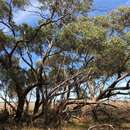pt-BR
nomes no trilho de navegação


Eucalyptus odorata ist eine Pflanzenart innerhalb der Familie der Myrtengewächse (Myrtaceae). Sie kommt im Südosten und im Zentrum von South Australia sowie im westlichen Victoria vor[1] und wird dort „Seaside Mallee“, „Mallee Box“, „Scented Box“, „Peppermint“ oder „Peppermint Box“ genannt.[2]
Eucalyptus odorata wächst als Baum oder in der Wuchsform der Mallee-Eukalypten, dies ist eine Wuchsform, die mehr strauchförmig als baumförmig ist, es sind meist mehrere Stämme vorhanden, die einen Lignotuber ausbilden,[3] der Wuchshöhen von 5 bis 10 Meter, manchmal auch bis 15 Meter, erreicht.[4] Die Borke verbleibt am gesamten Stamm und manchmal auch den größeren Ästen, ist grau, grau-braun oder schwarz, mit weißen Flecken und fasrig-stückig. Öldrüsen gibt es sowohl im Mark als auch in der Borke.[3]
Bei Eucalyptus odorata liegt Heterophyllie vor. Die Laubblätter sind stets in Blattstiel und Blattspreite gegliedert. An mittelalten Exemplaren ist die Blattspreite lanzettlich bis eiförmig, gerade, ganzrandig und matt grün. Die auf Ober- und Unterseite gleichfarbig matt grünen oder grau-grünen Blattspreiten an erwachsenen Exemplaren sind lanzettlich, relativ dick, sichelförmig gebogen, verjüngen sich zur Spreitenbasis hin und besitzen ein spitzes oberes Ende. Die erhabenen Seitennerven gehen in einem spitzen oder sehr spitzen Winkel vom Mittelnerv ab. Die Keimblätter (Kotyledone) sind umgekehrt nierenförmig.[3]
Seitenständig an einem im Querschnitt vierkantigen Blütenstandsschaft stehen in einem einfachen Blütenstand drei bis sieben oder bis zu elf Blüten zusammen. Die Blütenknospen sind eiförmig und nicht blaugrün bemehlt oder bereift. Die Kelchblätter bilden eine Calyptra, die bis zur Blüte (Anthese) vorhanden bleibt. Die glatte Calyptra ist halbkugelig oder konisch, ein- bis zweimal so lang wie der glatte Blütenbecher (Hypanthium) und ebenso breit wie dieser. Die Blüten sind weiß oder cremeweiß.[3]
Die Frucht ist zylindrisch, spindel- oder eiförmig. Der Diskus ist eingedrückt, die Fruchtfächer sind eingeschlossen.[3]
Das natürliche Verbreitungsgebiet von Eucalyptus odorata ist das Zentrum und der Südosten von South Australia sowie der Westen von Victoria.[1][3]
Der lichte, grasige Eucalyptus-odorata-Wald in South Australia wurde von einer Regierungskommission für die Einstufung als „critically endangered“ = stark gefährdet vorgeschlagen, weil seine Verbreitung stark abnimmt.[4]
Die Erstbeschreibung von Eucalyptus odorata erfolgte 1847 durch die deutschen Botaniker Hans Hermann Behr und Diederich Franz Leonhard von Schlechtendal unter dem Titel Südaustralische Pflanzen II. Bestimmung und Beschreibung der von Behr in Südaustralien gesammelten Pflanzen in Linnaea, Ausgabe 20, S. 657.[2][5][6] Das Typusmaterial weist die Beschriftung „Massiger Baum, an trockenen Stellen und auf leichtem Boden ziemlich allgemein verbreitet.“ auf. Synonyme für Eucalyptus odorata Behr sind Eucalyptus cajuputea Miq., Eucalyptus porosa F.Muell. ex Miq., Eucalyptus fruticetorum F.Muell. ex Miq., Eucalyptus odorata Behr var. odorata, Eucalyptus odorata var. angustifolia Blakely, Eucalyptus odorata var. calcicultrix Miq., Eucalyptus odorata var. refracta Blakely und Eucalyptus odorata var. erythrandra F.Muell. ex Miq.[2]
Es gibt zwei Varietäten von Eucalyptus odorata Behr:[6]
Mit Eucalyptus albopurpurea bildet Eucalyptus odorata Intergradationen und mit unterartlichen Intergradationen von Eucalyptus phenax eine natürliche Hybride.[2]
Eucalyptus odorata ist eine Pflanzenart innerhalb der Familie der Myrtengewächse (Myrtaceae). Sie kommt im Südosten und im Zentrum von South Australia sowie im westlichen Victoria vor und wird dort „Seaside Mallee“, „Mallee Box“, „Scented Box“, „Peppermint“ oder „Peppermint Box“ genannt.
Eucalyptus cajuputea, commonly known as the narrow-leaved peppermint box,[3] is a tree or a mallee that is endemic to South Australia. It usually has rough, flaky bark on the trunk, linear to narrow lance-shaped adult leaves, flower buds arranged in groups of seven to eleven, white flowers and smooth, cup-shaped to barrel-shaped fruit.
Eucalyptus cajuputea is a multi-stemmed tree or a mallee that typically grows to a height of 4–10 metres (13–33 ft) and forms a lignotuber. It has rough, hard to flaky, grey-brown bark up as far as medium branches and then smooth, coppery to pale grey to cream bark above. Leaves on young plants are linear to narrow lance-shaped and a dull greenish colour. Adult leaves are dull to glossy, slightly blue-green to green with a blade that is linear to narrow lance-shaped, 60–130 millimetres (2.4–5.1 in) long and 3–14 millimetres (0.12–0.55 in) wide. The flowers buds are arranged in leaf axils in groups of seven, nine or eleven on a peduncle 3–11 millimetres (0.12–0.43 in) long, the individual flowers on pedicels 2–6 millimetres (0.08–0.24 in) long. The mature buds are smooth, 5–8 millimetres (0.20–0.31 in) long and 2–4 millimetres (0.08–0.16 in) wide. The flowering period is not known but the flowers are white. The fruit is a smooth, cup-shaped to barrel-shaped capsule 3–6.5 millimetres (0.12–0.26 in) long and 3–5 millimetres (0.12–0.20 in) wide with the valves level with the rim or enclosed.[4][5]
This species was previously included with the very similar peppermint box (E. odorata) that has broader leaves, larger buds and fruit and a more southerly distribution.[5]
Eucalyptus cajuputea was first formally described by Friedrich Anton Wilhelm Miquel in 1856 and the description was published in the journal Nederlandsch Kruidkundig Archief.[6][7] The specific epithet (cajuputea) is derived from the Indonesian words kayu meaning white and putih meaning wood in reference to the melaleuca species (M. cajuputi) that has a similar wood colour and from which cajeput oil is traditionally produced.[5]
Narrow-leaved peppermint box is found in the northern portion of the Eyre Peninsula, in the Flinders Range and northern parts of the Mount Lofty Ranges. It is often found on rocky ridges and hillslopes on the adjacent footslopes and undulating plains growing in rocky sandy soils.[4][5]
Eucalyptus cajuputea, commonly known as the narrow-leaved peppermint box, is a tree or a mallee that is endemic to South Australia. It usually has rough, flaky bark on the trunk, linear to narrow lance-shaped adult leaves, flower buds arranged in groups of seven to eleven, white flowers and smooth, cup-shaped to barrel-shaped fruit.
Eucalyptus odorata là một loài thực vật có hoa trong Họ Đào kim nương. Loài này được Behr mô tả khoa học đầu tiên năm 1847.[1]
Eucalyptus odorata là một loài thực vật có hoa trong Họ Đào kim nương. Loài này được Behr mô tả khoa học đầu tiên năm 1847.